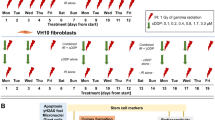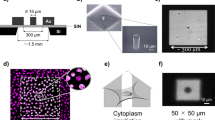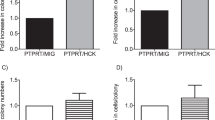Abstract
Epstein–Barr virus-immortalized lymphoblastoid cell lines were derived from five patients with late radionecrosis. Two of these cell lines exhibited postradiation viability levels intermediate between normal cell lines and that from an individual with ataxia telangiectasia. Compared with controls, these two cell lines exhibited impaired ability to rejoin DNA double-strand breaks on pulsed-field gel electrophoresis and 6–10-fold reduced DNA-dependent protein kinase (DNA-PK) activity in vitro in cell-free extracts. Immunoblotting showed normal levels of Ku70, Ku80 and XRCC4 and the presence of DNA-PKcs in both cell lines. These findings suggest that DNA-PK might be an important factor affecting the predisposition of radiotherapy patients to late radionecrosis.
This is a preview of subscription content, access via your institution
Access options
Subscribe to this journal
Receive 50 print issues and online access
$259.00 per year
only $5.18 per issue
Buy this article
- Purchase on Springer Link
- Instant access to full article PDF
Prices may be subject to local taxes which are calculated during checkout




Similar content being viewed by others
References
Alapetite C, Thirion P, de la Rochefordiere A, Cosset JM and Moustacchi E . (1999). Int. J. Cancer, 83, 83–90.
Allalunis-Turner J, Lintott LG, Barron GM, Day RS and Lees-Miller SP . (1995a). Cancer Res., 55, 5200–5202.
Allalunis-Turner J, Zia PK, Barron GM, Mirzayans R and Day III RS . (1995b). Radiat. Res., 144, 288–293.
Alsbeih G, Malone S, Lochrin C, Girard A, Fertil B and Raaphorst GP . (2000). Int. J. Radiat. Oncol. Biol. Phys., 46, 143–152.
Bjork-Eriksson T, West CM, Karlsson E, Slevin NJ, Davidson SE, James RD and Mercke C . (1998). Br. J. Cancer, 77, 2371–2375.
DiBiase SJ, Zeng ZC, Chen R, Hyslop T, Curran Jr WJ and Iliakis G . (2000). Cancer Res., 60, 1245–1253.
Godsen CM, Davidson C and Robertson M . (1986). Human Cytogenetics A Practical Approach, Rooney DE, Czepulowski BH (eds). IRL Press: Oxford, pp. 31–54.
Herring CJ, West CM, Wilks DP, Davidson SE, Hunter RD, Berry P, Forster G, MacKinnon J, Rafferty JA, Elder RH, Hendry JH and Margison GP . (1998). Br. J. Cancer, 78, 1128–1133.
Iliakis G . (1991). Bioessays, 13, 641–648.
Manley JL, Fire A, Samuels M and Sharp PA . (1983). Methods Enzymol., 101, 568–582.
O’Driscoll M, Cerosaletti KM, Girard PM, Dai Y, Stumm M, Kysela B, Hirsch B, Gennery A, Palmer SE, Seidel J, Gatti RA, Varon R, Oettinger MA, Neitzel H, Jeggo PA and Concannon P . (2001). Mol. Cell, 6, 1175–1185.
Polischouk AG, Cedervall B, Ljungquist S, Flygare J, Hellgren D, Grenman R and Lewensohn R . (1999). Int. J. Radiat. Oncol. Biol. Phys., 43, 191–198.
Price P and McMillan TJ . (1990). Cancer Res., 50, 1392–1396.
Safwat A, Bentzen SM, Turesson I and Hendry JH . (2002). Int. J. Radiat. Oncol. Biol. Phys., 52, 198–204.
Sirzen F, Nilsson A, Zhivotovsky B and Lewensohn R . (1999). Eur. J. Cancer, 35, 111–116.
Stewart GS, Maser RS, Stankovic T, Bressan DA, Kaplan MI, Jaspers NG, Raams A, Byrd PJ, Petrini JH and Taylor AM . (1999). Cell, 99, 577–587.
Taalman RD, Jaspers NG, Scheres JM, de Wit J and Hustinx TW . (1983). Mutat. Res., 112, 23–32.
Taylor AM, Harnden DG, Arlett CF, Harcourt SA, Lehmann AR, Stevens S and Bridges BA . (1975). Nature, 258, 427–429.
Tucker SL, Geara FB, Peters LJ and Brock WA . (1996). Radiother. Oncol., 38, 101–113.
West CM, Davidson SE, Elyan SE, Swindell R, Roberts SA, Orton CJ, Coyle CA, Valentine H, Wilks DP, Hunter RD and Hendry JH . (1998). Int. J. Radiat. Biol., 73, 409–413.
West CM, Davidson SE, Roberts SA and Hunter RD . (1997). Br. J. Cancer, 76, 1184–1190.
Woods T, Wang W, Convery E, Errami A, Zdzienicka MZ and Meek K . (2002). Nucleic Acids Res., 19, 5120–5128.
Zhao HJ, Hosoi Y, Miyachi H, Ishii K, Yoshida M, Nemoto K, Takai Y, Yamada S and Suzuki N . (2000). Clin. Cancer Res., 6, 1073–1078.
Acknowledgements
Our thanks to Professor Trevor McMillan and colleagues in Professor Malcolm Dunlop's group for discussion and advice, and to Professor Malcolm Paterson for a critical reading of the manuscript. This work was supported by grants from the Singapore National Cancer Centre, Singapore Cancer Society, the Singapore National Medical and SingHealth Research Councils, the Melville Trust for the Care and Cure of Cancer and the Scottish Hospitals Endowments Research Trust.
Author information
Authors and Affiliations
Corresponding author
Rights and permissions
About this article
Cite this article
Loong, S., Korzh, S. & Price, A. Reduced DNA-dependent protein kinase activity in two cell lines derived from adult cancer patients with late radionecrosis. Oncogene 23, 5562–5566 (2004). https://doi.org/10.1038/sj.onc.1207771
Received:
Revised:
Accepted:
Published:
Issue Date:
DOI: https://doi.org/10.1038/sj.onc.1207771



